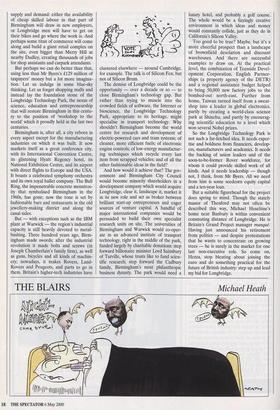JUST THE JOB FOR TARZAN
Martin Vander Weyer has a rescue
plan both for Longbridge and for Michael Heseltine
SAD to say, the most sensible proposal for the future of Rover, among the many that have emerged in the past few days, is the suggestion that if all else fails BMW will sell Longbridge's Rover 25 and 45 assem- bly lines to the Tata industrial group of Bombay. Tata would ship the machinery to India and build the cars for its domestic market, where they might be appreciated for the Britishness of their styling in a way that they no longer seem to be appreciated in Britain. Like the 1950s Morris Oxford which became India's ubiquitous Ambas- sador saloon, Rover designs would have a new lease of life. And BMW would salvage some scrap value from Longbridge to off- set its £2 million-a-day losses there.
But that would leave Longbridge with hundreds of acres of empty sheds and 8,500 people out of work, with 24,000 oth- ers likely to lose their jobs in components factories which depend on orders from Rover. Though the economy is generally buoyant and jobs are being created around the country in retailing and services as fast as they are being lost in manufacturing, it would be a rotten blow for the West Mid- lands. As is always said on these occasions, something must be done. This being an era of Labour government and a week of local elections, there is a cry that something must be done by government. But what, exactly? A chorus of economists, businessmen and others with memories of the failures of state interven- tion in the 1970s reply that the Trade Sec- retary Stephen Byers would be a fool and a vote-seeking knave to throw taxpayers' money behind the only bidder still at the table, the Phoenix consortium, which has failed to reveal any credible private-sector financial backing. DTI officials are said to be furious at Byers's inclination to ignore their advice and approve state handouts: he has just given a £100 million subsidy to RIB Mining to keep open a handful of coal pits. He may now be about to offer Phoenix the £129 million he was prepared if the European Commission would let him — to offer BMW for the redevelop- ment of Longbridge. But insiders say Phoenix needs as much as £700 million to get it to the starting line. Given the central weakness of any Rover business plan — the fact that so few motorists want to drive Rover cars — any rescue that Phoenix and Byers can scram- ble together seems likely merely to defer the death of Longbridge until some hap- less Byers successor at the DTI can shoul- der the blame.
The government, then, is in an odd posi- tion. It has money coming out of its ears — a budget surplus for last year of £15 bil- lion, which was £3 billion more than Gor- don Brown forecast, and a £22.5 billion windfall from the third-generation mobile phone licence auction, which was £20 bil- lion more than the Treasury expected. If ever there was a time for largesse, this is it. Yet the only project into which the govern- ment has got away with injecting £700 mil- lion is its vain and ephemeral Millennium Dome. If Byers were to propose anything on that scale for Rover, there would be a huge outcry — from Parliament, from Brussels, from all the less favoured suppli- cants for state funds.
It can't be done, and nor has anyone taken seriously the Guardian's suggestion that the auction proceeds should be spent on buying euros in order to drive down the value of the pound and ease the pressure on British exporters, Rover and Ford included. Prudent Gordon has decided sim- ply to invest his winnings in a reduction of the national debt, reducing the annual cost of paying interest on gilt-edged stock by £1 billion or so. All that can be done for Longbridge in the meantime, if Phoenix fails, is to provide a few million in grants for retraining and local enterprise schemes to soften the blow. Gordon's new ortho- doxy says that tighter control of state spending, including interest payments, equates to lower tax rates which leave more resources available for private-sector investment, which leads to higher growth and more jobs. And that is a lot better than pouring money into unfillable black holes in the Black Country.
The new orthodoxy is right in principle but it does not provide bold solutions to regional employment disasters like Long- bridge. Those it leaves to the workings of supply and demand: either the availability of cheap skilled labour in that part of Birmingham will draw in new employers, or Longbridge men will have to get on their bikes and go where the work is. And perhaps some titan of commerce will come along and build a giant retail complex on the site, even bigger than Merry Hill at nearby Dudley, creating thousands of jobs for shop assistants and carpark attendants.
But perhaps we can do better than that, using less than Mr Byers's £129 million of taxpayers' money but a lot more imagina- tion. Let us indulge in some blue-sky thinking. Let us forget shopping malls and instead lay the foundation stone of the Longbridge Technology Park, the nexus of science, education and entrepreneurship that will restore Birmingham in this centu- ry to the position of 'workshop to the world' which it proudly held in the last two centuries.
Birmingham is, after all, a city reborn in every aspect except for the manufacturing industries on which it was built. It now markets itself as a great conference city, with its International Convention Centre, its glistening Hyatt Regency hotel, its National Exhibition Centre, and its airport with direct flights to Europe and the USA. It boasts a celebrated symphony orchestra and its own royal ballet company. The Bull Ring, the impenetrable concrete monstros- ity that symbolised Birmingham in the 1960s, has gone; now the tone is set by fashionable bars and restaurants in the old jewellery-making district and along the canal sides.
But — with exceptions such as the IBM plant at Warwick — the region's industrial capacity is still heavily devoted to metal- bashing. Three hundred years ago, Birm- ingham made swords; after the industrial revolution it made bolts and screws (in Joseph Chamberlain's family firm), as well as guns, bicycles and all kinds of machin- ery; nowadays, it makes Rovers, Land- Rovers and Peugeots, and parts to go in them. Britain's higher-tech industries have clustered elsewhere — around Cambridge, for example. The talk is of Silicon Fen, but not of Silicon Brum.
The demise of Longbridge could be the opportunity — over a decade or so — to close Birmingham's technology gap. But rather than trying to muscle into the crowded fields of software, the Internet or bioscience, the Longbridge Technology Park, appropriate to its heritage, might specialise in transport technology. Why shouldn't Birmingham become the world centre for research and development of electric-powered cars and tram systems; of cleaner, more efficient fuels; of electronic engine controls; of low-energy manufactur- ing techniques which recycle every last item from scrapped vehicles; and of all the other fashionable ideas in the field?
And how would it achieve that? The gov- ernment and Birmingham City Council would become minority shareholders in a development company which would acquire Longbridge, clear it, landscape it, market it in its new role and act as broker between brilliant start-up entrepreneurs and eager sources of venture capital. A handful of major international companies would be persuaded to build their own specialist research units on site. The universities of Birmingham and Warwick would co-oper- ate in an advanced institute of transport technology, right in the middle of the park, funded largely by charitable donations: step forward billionaire minister Lord Sainsbury of Turville, whose trusts like to fund scien- tific research; step forward the Cadbury family, Birmingham's most philanthropic business dynasty. The park would need a luxury hotel, and probably a golf course. The whole would be a fizzingly creative environment in which ideas and money would constantly collide, just as they do in California's Silicon Valley.
Too good to be true? Maybe, but it's a more cheerful prospect than a landscape of brownfield desolation and discount warehouses. And there are successful examples to draw on. At the practical level, the combination of Teesside Devel- opment Corporation, English Partner- ships (a property agency of the DETR) and a regional assistance budget helped to bring 50,000 new factory jobs to the bombed-out north-east. Further from home, Taiwan turned itself from a sweat- shop into a leader in global electronics, partly by creating a world-class science park at Shinchu, and partly by encourag- ing scientific education to a level which won several Nobel prizes.
So the Longbridge Technology Park is not such a far-fetched idea. It needs exper- tise and boldness from financiers, develop- ers, manufacturers and academics. It needs the backing of union leaders and of the soon-to-be-former Rover workforce, for whom it could provide skilled work of all kinds. And it needs leadership — though not, I think, from Mr Byers. All we need from him is some seedcorn equity capital and a ten-year loan.
But a suitable figurehead for the project does spring to mind. Though the stately manor of Thenford may not often be described this way, Michael Heseltine's home near Banbury is within convenient commuting distance of Longbridge. He is Britain's Grand Project manager manqué. Having just announced his retirement from politics — and despite protestations that he wants to concentrate on growing trees — he is surely in the market for one last non-executive role. So come on, Hezza, stop bleating about joining the euro and do something practical for the future of British industry: step up and lead my bid for Longbridge.



































































 Previous page
Previous page